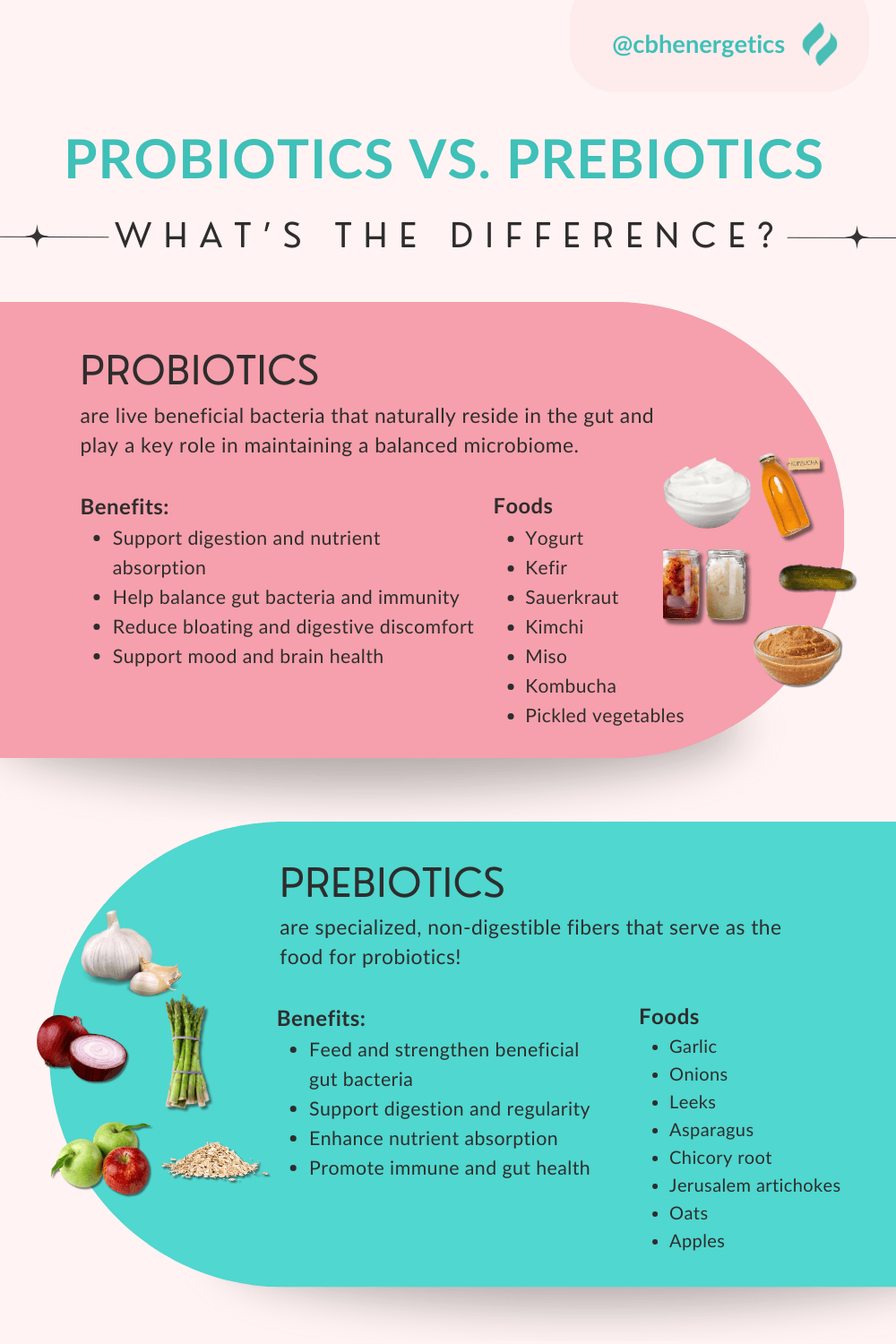
How to Choose a Probiotic That Actually Works for You
Ever stare at the endless wall of probiotics at the store, wondering which one is worth your money? Do you really need one, or can you just eat yogurt and call it a day? With so many options out there, how to choose a probiotic can feel like a guessing game.
But picking the right probiotic isn’t just about grabbing the most expensive bottle or the one with the highest CFUs (colony-forming units). It’s about finding the right one for you that supports a balanced gut and aligns with your specific health needs. Some probiotics target digestion, while others help with mood, immunity, or even metabolism.
In this ultimate probiotic guide, we’ll break down what probiotics really do, which strains may work best for different health goals, and much more. Let’s get started!
What Are Probiotics?
Probiotics are living microorganisms—mostly beneficial bacteria and yeasts—that support your gut’s natural ecosystem.
Your gut is home to trillions of microbes, collectively known as the gut microbiome. This complex community includes bacteria, fungi, viruses, and other tiny organisms that work together to keep your body functioning. A well-balanced microbiome helps break down food, produce essential nutrients like B vitamins and vitamin K, and keep harmful bacteria in check. But if your microbiome gets thrown off—due to stress, antibiotics, poor diet, environmental toxins, and more—you might start noticing bloating, irregular digestion, fatigue, or even brain fog. This imbalance, called dysbiosis, can contribute to a range of health concerns, making it even more important to support your gut with the right probiotic strains.
That’s where knowing how to choose a probiotic comes in. Whether you’re taking supplements or incorporating fermented foods, you want to make sure you’re supporting your gut in a way that encourages a balanced gut.
Different Kinds of Probiotic Strains – Why So Many?
Not all probiotics are created equal, and different strains have different benefits. When choosing a probiotic, you’ll see a variety of strains listed, each with a specific purpose:
- Naturally present in the human gut, making them well-adapted to support digestion and immunity.
- Backed by research on their safety, effectiveness, and health benefits.
- Resilient enough to survive digestion, ensuring they reach the intestines where they can be beneficial.
What Are the Benefits of Probiotics?
Probiotics do more than just support a balanced gut—they influence everything from immunity to mental health.
- Supports Digestion & Reduces Bloating
Certain strains help break down food, absorb nutrients, and keep bowel movements regular. Probiotics like Lactobacillus acidophilus and Bifidobacterium bifidum aid digestion, reduce bloating and support gut lining integrity.
- Strengthens the Gut Barrier & Supports Immune Health
Around 70% – 80% of your Immune System resides in your gut. Probiotics like Lactobacillus rhamnosus GG and Bifidobacterium breve help strengthen the gut barrier and support immune function.
- Nervous System Support – Helps Mood and Mental Wellbeing
Ever had a “gut feeling” about something? That’s not just a saying—your gut and brain are in constant communication through the gut-brain axis, a network that links your Digestive System with your Nervous System. Probiotics influence the production of neurotransmitters like serotonin and GABA, which help regulate mood, stress, and even sleep. Research suggests that a balanced microbiome can improve resilience to stress, reduce symptoms of anxiety and depression, and support cognitive function. Lactobacillus rhamnosus GG and Bifidobacterium longum have been studied for their ability to promote stress resilience and improve mood.
- Supports Skin Health
Probiotics can help reduce inflammation, which can affect skin conditions like acne and eczema. Lactobacillus reuteri supports skin hydration, while Lactobacillus rhamnosus GG has shown improvements in eczema and overall skin health.
- Weight Maintenance & Metabolic Health
A healthy microbiome plays a role in metabolism, appetite regulation, and fat storage. Bifidobacterium lactis B420 is a well-researched strain for weight maintenance. It may help reduce body fat, regulate blood sugar, and strengthen the gut barrier to support metabolic health.
- Hormone Balance & Endocrine Support
A balanced gut supports hormone regulation, affecting everything from stress hormones to reproductive health. Lactobacillus reuteri has been studied for its effects on testosterone and oxytocin.

Getting Probiotics from Food: A Great Start, But Is It Enough?
Eating probiotic-rich foods is one of the easiest ways to support your gut, and many traditional diets have included fermented foods for centuries. Every culture throughout history has consumed some form of fermented food—from kimchi in Korea to miso in Japan, sauerkraut in Germany, and kvass in Eastern Europe. Here are some of the best natural sources, including dairy-free options:
- Yogurt – Contains Lactobacillus and Bifidobacterium strains, but effectiveness depends on whether the yogurt has live, active cultures.
- Kefir – A fermented dairy drink with a wider variety of probiotic strains than yogurt, including some that may colonize the gut longer.
- Sauerkraut & Kimchi – Fermented cabbage rich in Lactobacillus species, though store-bought versions are often pasteurized, killing off live bacteria.
- Miso & Tempeh – Fermented soy products containing Bacillus species, which may help with digestion and immune function.
- Kombucha – A fermented tea that contains Saccharomyces boulardii, a beneficial yeast that can support gut balance and improve gut health in those with clostridium bacteria.
- Fermented Vegetables & Pickles – Only naturally fermented versions, not with vinegar, contain live probiotics.
However, probiotic foods may not provide the targeted, high-dose strains needed for specific health concerns. Many bacteria in food don’t survive stomach acid. Combining probiotic foods with supplements can offer the best of both worlds.
Probiotics vs. Prebiotics—What’s the Difference?
You’ve probably heard of prebiotics, too.
If probiotics are the live, beneficial bacteria that help maintain a balanced gut, then prebiotics are the fuel that helps them thrive. They’re indigestible fibers in foods like garlic, onions, green bananas, and asparagus that help probiotics thrive and do their job effectively.
Prebiotics also help probiotics survive digestion. Stomach acid can destroy many beneficial bacteria before they reach the intestines, but prebiotics help ensure they make it to where they can be beneficial.

How to Choose A Probiotic That’s Right for You
With so many probiotic options available, how do you choose a probiotic that’s right for you? The best probiotic isn’t a one-size-fits-all choice—it depends on your health goals, specific needs, and even your lifestyle. Here’s what to consider:
1. Hone in on your health! At CBH, we say, ‘test, don’t guess.’ Our most comprehensive bioenergetic scan, the Full Scan, provides an optional balancing regimen that may include a probiotic that is right for you!! Get zeroed in on your health goals, which may include eating probiotic-rich foods, reducing sugar, and so much more, all of which can benefit a balanced gut.
2. Pay Attention to CFUs (Colony-Forming Units)
CFUs measure the number of live bacteria in a probiotic. A higher CFU count isn’t always better—the ideal amount depends on the strains and their intended purpose. A typical guideline is:
- 5–10 billion CFUs: Great for daily maintenance.
- 10–50 billion CFUs: Often recommended for digestive support.
- 50+ billion CFUs: Typically used for more intensive gut support, such as after antibiotic use or for chronic gut concerns.
3. Check Expiration Dates and Storage Needs
Since probiotics contain living organisms, their potency can decline over time. Check the expiration date to ensure you’re getting active, beneficial bacteria. Some probiotics require refrigeration to maintain effectiveness, while others are shelf-stable—so always check the label for storage recommendations.
By following this probiotic guide, you can find the right probiotic tailored to your health goals!
So, Do You Really Need Probiotics?
Probiotics have gained a lot of attention for their gut-supporting benefits, but are they something everyone needs? The short answer: It depends.
A well-balanced gut microbiome naturally maintains itself, but modern lifestyles can throw this balance off. Some people may need probiotics more than others, especially during certain life stages or after specific events.
- If You’ve Recently Taken Antibiotics
Antibiotics are great when needed, but they also wipe out beneficial gut bacteria. - If You Struggle with Chronic Gut Issues
Issues like IBS, Crohn’s, and ulcerative colitis often involve gut microbiome imbalances. A single-strain probiotic such as Saccharomyces boulardii has scientific evidence to support it. - If You Have Food Sensitivities or Intolerances
Many people with food sensitivities, lactose intolerance, gluten sensitivity, or histamine intolerance have underlying gut imbalances that contribute to their symptoms. - If You Travel Frequently
Traveler’s diarrhea is a common issue, especially when visiting regions with unfamiliar bacteria. Saccharomyces boulardii has been widely studied for its ability to prevent traveler’s diarrhea by keeping harmful pathogens in check and strengthening gut defenses. Taking it before and during travel may help reduce digestive upset. - As You Age
The diversity of gut bacteria naturally declines with age, which can impact digestion, immunity, and even cognitive function. Older adults may benefit from probiotics to support gut health, especially Bifidobacterium breve, which has been studied for its role in healthy aging.
FAQs: Probiotics and Common Mistakes to Avoid
When is the best time to take probiotics?
Many probiotics are best taken on an empty stomach, while others work better with meals—check the label.
How long does it take for probiotics to work?
Results vary. Some people notice digestive improvements in a few days, while others may need a few weeks for gut health to stabilize.
Can I take probiotics while on antibiotics?
Yes! Taking probiotics alongside antibiotics can help replenish beneficial bacteria. Just take them a few hours apart to avoid interference.
What are common mistakes when taking probiotics?
- Expecting instant results—probiotics may need time to work.
- Choosing the wrong strain for your needs.
- Not storing them correctly—some require refrigeration.
- Taking them inconsistently—regular use is key.
Can probiotics cause bloating?
Yes, some people experience mild bloating at first as their gut adjusts. This usually resolves within a few days. If you’re new to probiotics, starting with a lower CFU count and gradually increasing can help prevent bloating or discomfort.
Finding the Right Probiotic for Your Needs
Finding the right probiotic doesn’t have to be overwhelming. By following this probiotic guide, you can make informed choices that support a balanced gut. Whether you’re looking for daily digestive support or targeted benefits, knowing how to choose a probiotic ensures you’re getting the best for your health. Stick with quality strains, stay consistent, and give your gut the support it needs!
Want to see how your gut health measures up? A bioenergetic scan can help identify food and environmental sensitivities, as well as nutritional and hormone imbalances!

